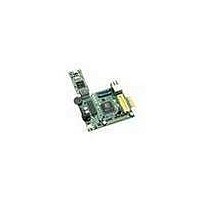M1AFS-EMBEDDED-KIT Actel, M1AFS-EMBEDDED-KIT Datasheet - Page 39

M1AFS-EMBEDDED-KIT
Manufacturer Part Number
M1AFS-EMBEDDED-KIT
Description
MCU, MPU & DSP Development Tools CortexM1-enabled Fusion Embedded Kit
Manufacturer
Actel
Datasheet
1.M1AFS-EMBEDDED-KIT.pdf
(56 pages)
Specifications of M1AFS-EMBEDDED-KIT
Lead Free Status / RoHS Status
Lead free / RoHS Compliant
Table 7-2 • JTAG 20-Pin Connector Signals
The signals on the 20-pin JTAG interface are shown in
Signal
DBGACK
DBGRQ
GND
nSRST
nTRST
RTCK
TCK
TDI
TDO
TMS
V
VT
SUPPLY
REF
Output
Output
Output
Output
output
Input/
Input
Input
Input
Input
I/O
–
–
–
This pin is connected in the RealView ICE run control unit, but is not
supported in the current release of the software. It is reserved for compatibility
with other equipment to be used as a debug acknowledge signal from the
target system. Actel recommends pulling this signal LOW on the target.
This pin is connected in the RealView ICE run control unit, but is not
supported in the current release of the software. It is reserved for compatibility
with other equipment, to be used as a debug request signal to the target
system. This signal is tied LOW. When applicable, RealView ICE uses the
core's scanchain 2 to put the core in debug state. Actel recommends pulling
this signal LOW on the target.
Ground
Open collector output from RealView ICE to the target system reset. This is
also an input to RealView ICE so that a reset initiated on the target can be
reported to the debugger. This pin must be pulled HIGH on the target to avoid
unintentional resets when there is no connection.
Open collector output from RealView ICE to the Reset signal on the target
JTAG port. This pin must be pulled HIGH on the target to avoid unintentional
resets when there is no connection.
Return Test Clock signal from the target JTAG port to RealView ICE. Some
targets must synchronize the JTAG inputs to internal clocks. To assist in
meeting this requirement, a returned, and retimed, TCK can be used to
dynamically control the TCK rate. RealView ICE provides Adaptive Clock
Timing, which waits for TCK changes to be echoed correctly before making
further changes. Targets that do not have to process TCK can simply ground
this pin.
Test Clock signal from RealView ICE to the target JTAG port. Actel
recommends pulling this pin LOW on the target.
Test Data In signal from RealView ICE to the target JTAG port. Actel
recommends pulling this pin HIGH on the target.
Test Data Out from the target JTAG port to RealView ICE. Actel recommends
pulling this pin HIGH on the target.
Test Mode signal from RealView ICE to the target JTAG port. This pin must be
pulled HIGH on the target to avoid adverse effects from any spurious TCKs
when there is no connection.
This pin is not connected in the RealView ICE run control unit. It is reserved
for compatibility with other equipment to be used as a power feed from the
target system.
This is the target reference voltage. It indicates that the target has power, and
It must be at least 0.628 V. VT
hardware and might have a series resistor (though this is not recommended).
There is a 10 kB pull-down resistor on VT
R ev i si o n 1 2
Table
Description
REF
7-2.
is normally fed from V
REF
in RealView ICE.
Cortex-M1 v3.1 Handbook
DD
on the target
39











